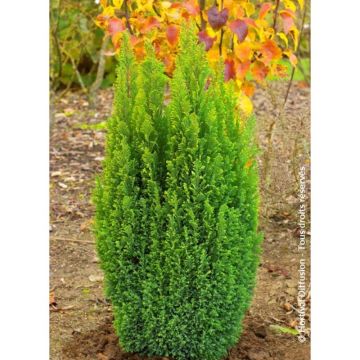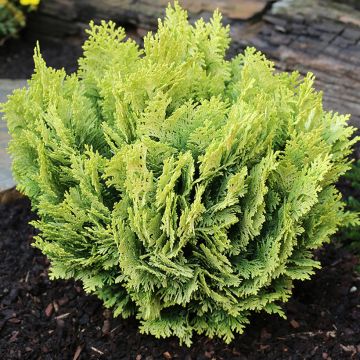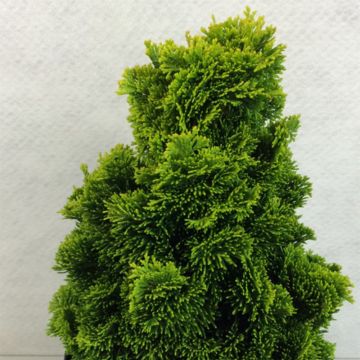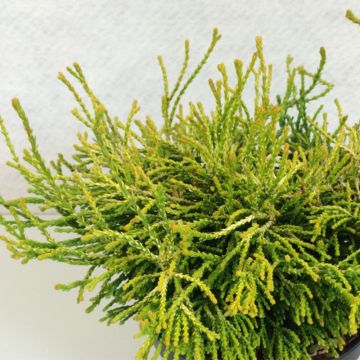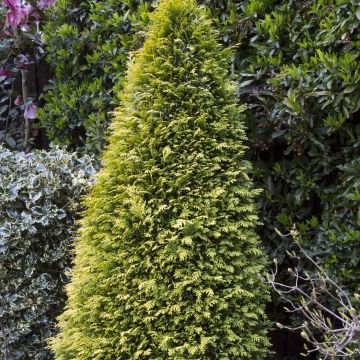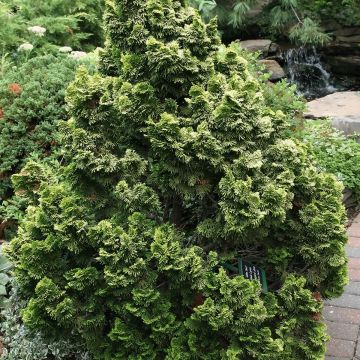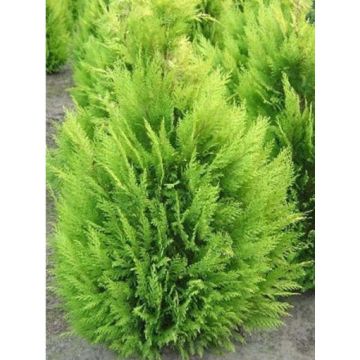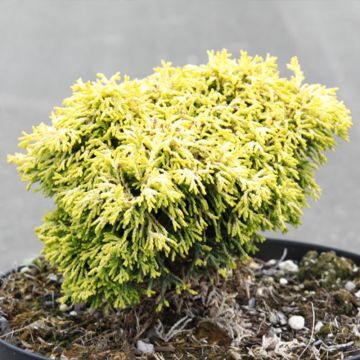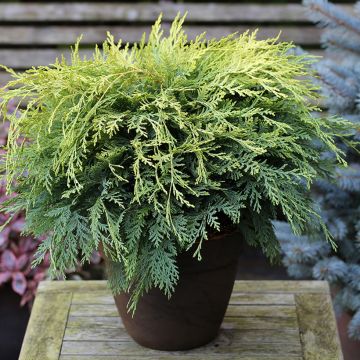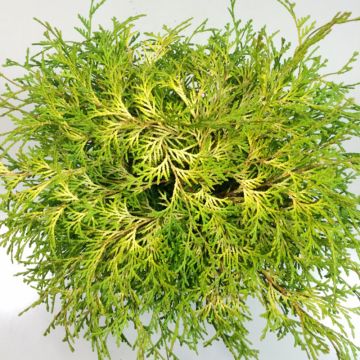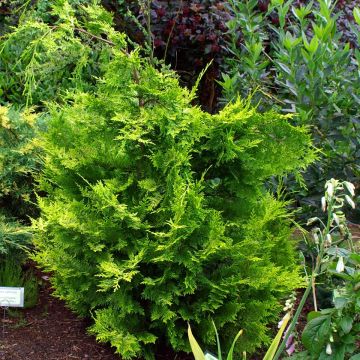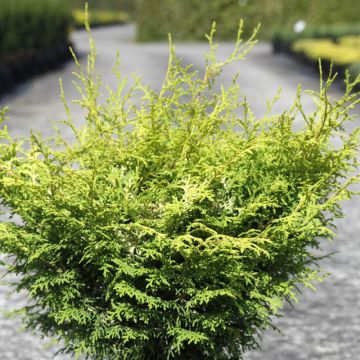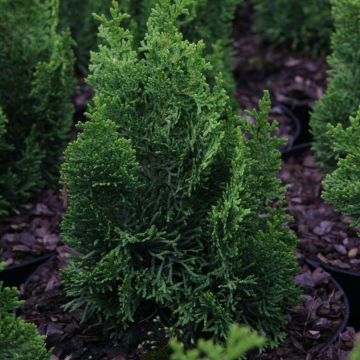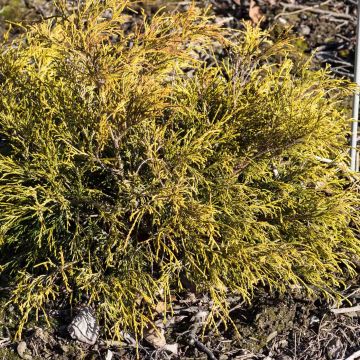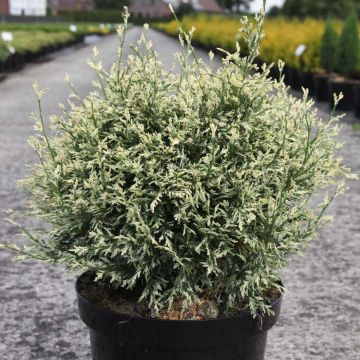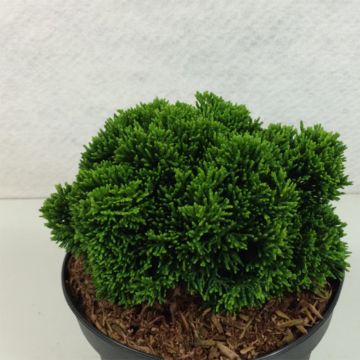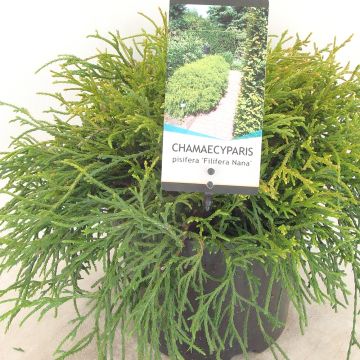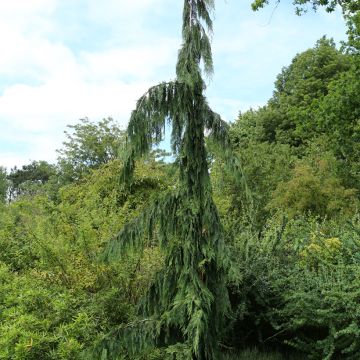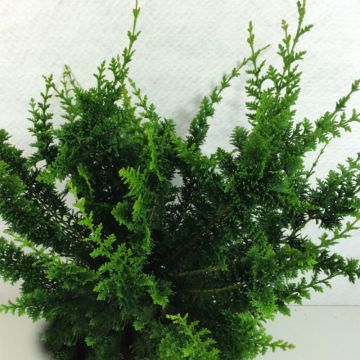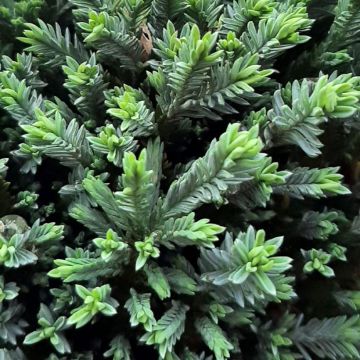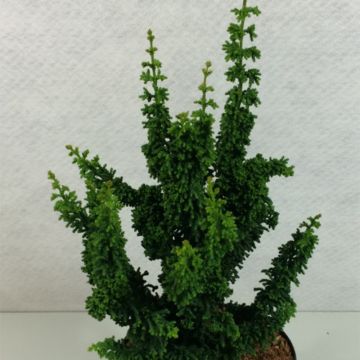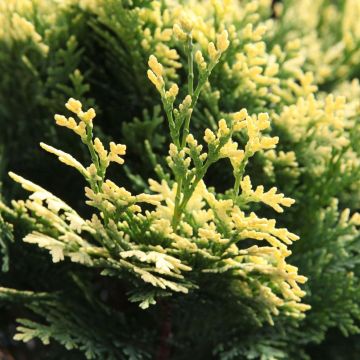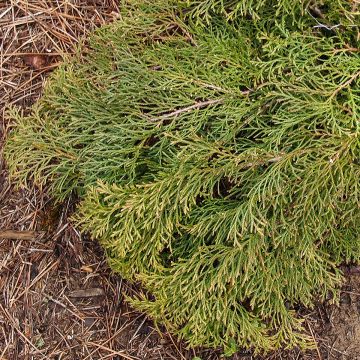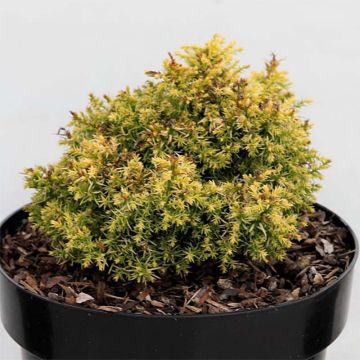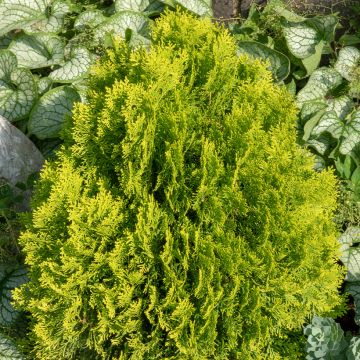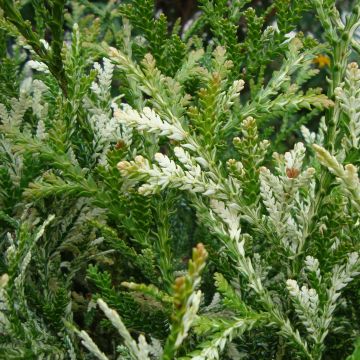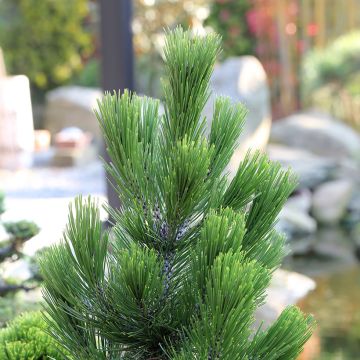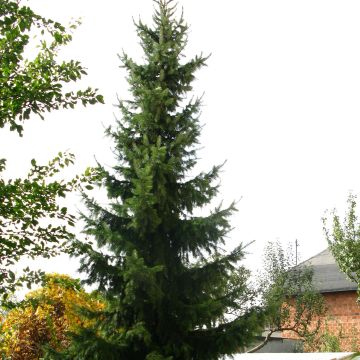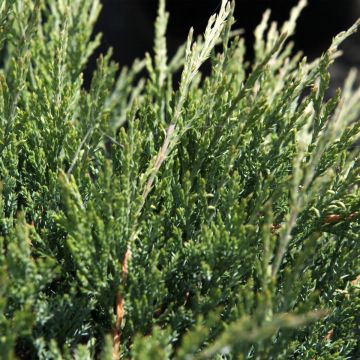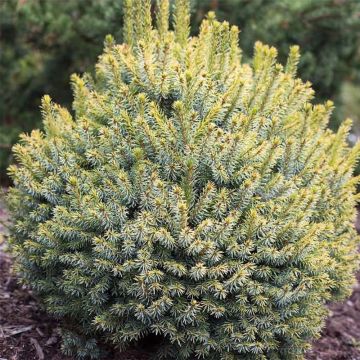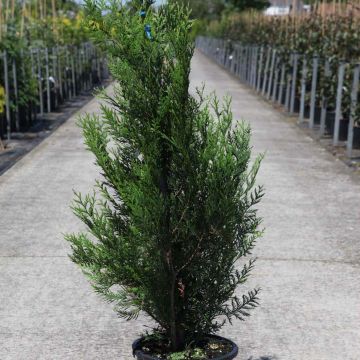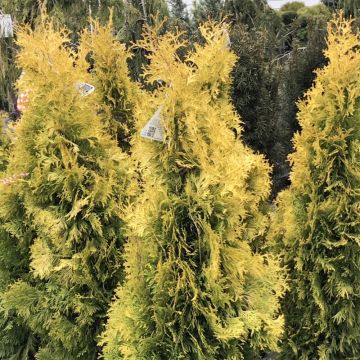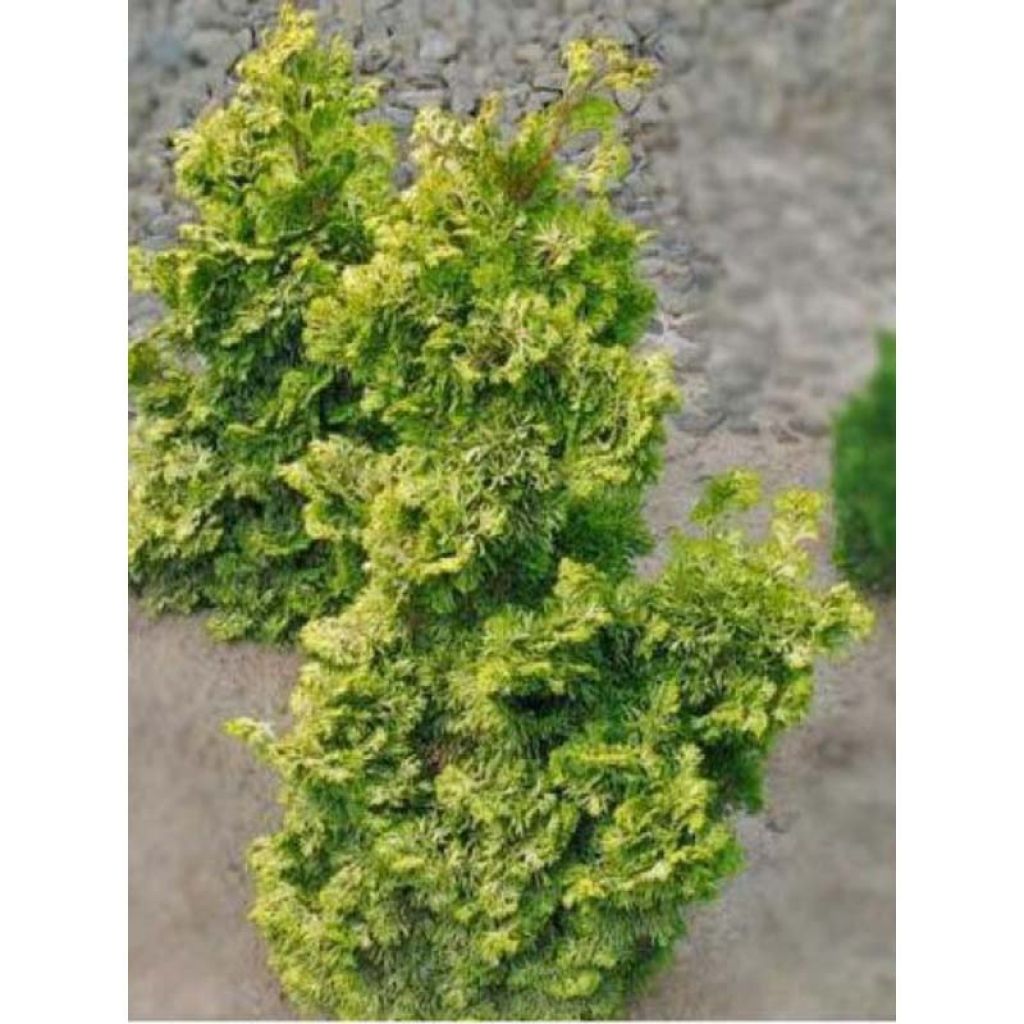

Chamaecyparis obtusa Rashahiba - Hinoki Cypress
Chamaecyparis obtusa Rashahiba - Hinoki Cypress
Chamaecyparis obtusa Rashahiba
Hinoki Cypress, Japanese Cypress, Hinoki False Cypress
Why not try an alternative variety in stock?
View all →This plant carries a 24 months recovery warranty
More information
We guarantee the quality of our plants for a full growing cycle, and will replace at our expense any plant that fails to recover under normal climatic and planting conditions.
From €5.90 for pickup delivery and €6.90 for home delivery
Express home delivery from €8.90.
From €5.90 for pickup delivery and €6.90 for home delivery
Express home delivery from €8.90.
Does this plant fit my garden?
Set up your Plantfit profile →
Description
The Chamaecyparis obtusa Rashahiba is a compact form of the Japanese hinoki false cypress with golden foliage, whose original silhouette seems to be in perpetual motion. Its flat and thick branches with a feathery appearance gracefully tousle in a beautiful range of yellow and acidic green, very bright, which becomes more bronze in the winter. Slow-growing, it will reach a height of 1m (3 ft 4 in) in 10 years. This slightly unkempt and highly colourful conifer will bring life to small spaces, flower beds, or rockeries throughout the year. It adapts remarkably well to container cultivation. It prefers a sunny or semi-shaded exposure, fertile soil, somewhat moist but well-drained, humus-rich, non-limestone.
The obtuse false cypress, also known as the Japanese Hinoki cypress, is a type of tree that belongs to the Cypress family. It is often used in Japan to make lacquered furniture and to build palaces. This tree can grow up to 50m (164ft) tall in its natural environment. There is also a dwarf variety called 'Rashahiba', which grows more slowly and has thick, somewhat tortuous branches that give it an unpredictable, informal upright habit. After many years of cultivation, an adult specimen of this tree usually measures around 1.50m (4ft 11in) in height and 1m (3ft 4in) in width. The tree's foliage is yellow when it's young but becomes greener as it ages, giving it a feathery appearance.
Chamaecyparis obtusa 'Rashahiba' is a unique and bright conifer plant that grows slowly and remains small, making it perfect for growing in containers on terraces or in small gardens. Its untrimmed shape adds to its eccentricity and makes it ideal for rockeries, especially when paired with darker varieties. Dwarf conifers are an excellent addition to contemporary gardens, focusing on shapes, silhouettes, and textures rather than flowers. These plants add a sense of permanence and structure to flowerbeds, pathway borders, and terraces and can easily soften the strong presence of trimmed boxwood. They work well as a background for miniature roses, peonies, or tousled grasses, as they complement each other nicely. Additionally, they can be paired with shrubs or ground-cover plants, like aubrietas, ceraistes, and flowering shrubs, to create a visually appealing garden. Playing with volumes and colours is the key to creating a beautiful garden design.
Tips: Water during periods of high heat as it is sensitive to drought.
Report an error about the product description
Chamaecyparis obtusa Rashahiba - Hinoki Cypress in pictures


Plant habit
Foliage
Botanical data
Chamaecyparis
obtusa
Rashahiba
Cupressaceae
Hinoki Cypress, Japanese Cypress, Hinoki False Cypress
Cultivar or hybrid
Other Chamaecyparis
Planting and care
The Chamaecyparis obtusa 'Rashahiba' prefers rich, cool, well-drained and neutral to slightly acidic soil. It's important to avoid limestone and drought conditions. Look for a sunny or partly shady spot sheltered from strong winds. Before you plant, soak the clumps well and add an organic material. Water it abundantly for the first few years. Add a special conifer fertiliser in April and hoe the soil in the summer. You don't have to prune the tree, but you can cut the tender shoots of young plants to form a hedge. Just be careful not to prune into old wood on older trees because no new shoots will grow there.
Planting period
Intended location
Care
This item has not been reviewed yet - be the first to leave a review about it.
Conifers
Haven't found what you were looking for?
Hardiness is the lowest winter temperature a plant can endure without suffering serious damage or even dying. However, hardiness is affected by location (a sheltered area, such as a patio), protection (winter cover) and soil type (hardiness is improved by well-drained soil).

Photo Sharing Terms & Conditions
In order to encourage gardeners to interact and share their experiences, Promesse de fleurs offers various media enabling content to be uploaded onto its Site - in particular via the ‘Photo sharing’ module.
The User agrees to refrain from:
- Posting any content that is illegal, prejudicial, insulting, racist, inciteful to hatred, revisionist, contrary to public decency, that infringes on privacy or on the privacy rights of third parties, in particular the publicity rights of persons and goods, intellectual property rights, or the right to privacy.
- Submitting content on behalf of a third party;
- Impersonate the identity of a third party and/or publish any personal information about a third party;
In general, the User undertakes to refrain from any unethical behaviour.
All Content (in particular text, comments, files, images, photos, videos, creative works, etc.), which may be subject to property or intellectual property rights, image or other private rights, shall remain the property of the User, subject to the limited rights granted by the terms of the licence granted by Promesse de fleurs as stated below. Users are at liberty to publish or not to publish such Content on the Site, notably via the ‘Photo Sharing’ facility, and accept that this Content shall be made public and freely accessible, notably on the Internet.
Users further acknowledge, undertake to have ,and guarantee that they hold all necessary rights and permissions to publish such material on the Site, in particular with regard to the legislation in force pertaining to any privacy, property, intellectual property, image, or contractual rights, or rights of any other nature. By publishing such Content on the Site, Users acknowledge accepting full liability as publishers of the Content within the meaning of the law, and grant Promesse de fleurs, free of charge, an inclusive, worldwide licence for the said Content for the entire duration of its publication, including all reproduction, representation, up/downloading, displaying, performing, transmission, and storage rights.
Users also grant permission for their name to be linked to the Content and accept that this link may not always be made available.
By engaging in posting material, Users consent to their Content becoming automatically accessible on the Internet, in particular on other sites and/or blogs and/or web pages of the Promesse de fleurs site, including in particular social pages and the Promesse de fleurs catalogue.
Users may secure the removal of entrusted content free of charge by issuing a simple request via our contact form.
The flowering period indicated on our website applies to countries and regions located in USDA zone 8 (France, the United Kingdom, Ireland, the Netherlands, etc.)
It will vary according to where you live:
- In zones 9 to 10 (Italy, Spain, Greece, etc.), flowering will occur about 2 to 4 weeks earlier.
- In zones 6 to 7 (Germany, Poland, Slovenia, and lower mountainous regions), flowering will be delayed by 2 to 3 weeks.
- In zone 5 (Central Europe, Scandinavia), blooming will be delayed by 3 to 5 weeks.
In temperate climates, pruning of spring-flowering shrubs (forsythia, spireas, etc.) should be done just after flowering.
Pruning of summer-flowering shrubs (Indian Lilac, Perovskia, etc.) can be done in winter or spring.
In cold regions as well as with frost-sensitive plants, avoid pruning too early when severe frosts may still occur.
The planting period indicated on our website applies to countries and regions located in USDA zone 8 (France, United Kingdom, Ireland, Netherlands).
It will vary according to where you live:
- In Mediterranean zones (Marseille, Madrid, Milan, etc.), autumn and winter are the best planting periods.
- In continental zones (Strasbourg, Munich, Vienna, etc.), delay planting by 2 to 3 weeks in spring and bring it forward by 2 to 4 weeks in autumn.
- In mountainous regions (the Alps, Pyrenees, Carpathians, etc.), it is best to plant in late spring (May-June) or late summer (August-September).
The harvesting period indicated on our website applies to countries and regions in USDA zone 8 (France, England, Ireland, the Netherlands).
In colder areas (Scandinavia, Poland, Austria...) fruit and vegetable harvests are likely to be delayed by 3-4 weeks.
In warmer areas (Italy, Spain, Greece, etc.), harvesting will probably take place earlier, depending on weather conditions.
The sowing periods indicated on our website apply to countries and regions within USDA Zone 8 (France, UK, Ireland, Netherlands).
In colder areas (Scandinavia, Poland, Austria...), delay any outdoor sowing by 3-4 weeks, or sow under glass.
In warmer climes (Italy, Spain, Greece, etc.), bring outdoor sowing forward by a few weeks.

































